For years we’ve all heard about how the sport of show jumping has changed dramatically–and not always for the better–over the past decade or two. Our old-school horsemen regularly reminisce about the days when our sport developed well-rounded horsemen and lament over the “riders” we’re turning out today. In our modern, quick fix culture, however, where everyone seeks immediate gratification in all aspects of life, it’s not surprising that that mentality should transfer to horse sports. When your competitors seek to sidestep the essential elements of time and hard work to achieve their goals, how do you keep pace?
This week, columnist Linda Allen addresses just this issue in her revealing article “Being A Jumping Rider Means More Than Just Riding A Jumper” (p. 40). Setting goals and working hard to achieve them–whether in small increments or through major achievements–is one key component in advancing your riding skills and to forging that all-important relationship with your horse.
Linda would like to see more riders setting goals with the horse in mind, considering his talents and respecting his limitations. And when a rider achieves this balance, when he understands the nuances of his horse, the animal’s strengths and weaknesses and is tuned in to his partner’s health and well-being, is the moment he takes that crucial next step in his education and becomes a horseman rather than simply a rider.
Similarly, that foundation Linda seeks to establish in riders is also important to the horses and transcends to the young jumper division, of which Linda is also a driving force. In the article “Young Jumper Classes Provide A Roadmap For Developing Horses” (p. 14) supporters of the program and riders with young jumpers discuss how and why this new division is working and the benefits they’re seeing as the program evolves into a core component of our show jumping sport.
ADVERTISEMENT
Although the program is still being fine-tuned, these divisions for 5- to 8-year-olds are becoming incredibly valuable in the development of our future international equine stars. No longer are these youngsters being pushed to compete against older and more experienced horses, they now have a place to shine and to develop a solid foundation at a pace that will keep them jumping for many years to come.
Nurturing the young riders and horses and providing them with the solid basis to succeed is of the utmost importance in today’s sport as the temptations to take shortcuts abound. Unfortunately, due to the many outside pressures on today’s young people, many no longer have the opportunity to spend significant time in the barn as the previous generation of children had. One of my first trainers was an old-school horseman who believed in teaching her charges everything, from stripping stalls and mixing feed to longeing and braiding. It was an invaluable education that I’m grateful to have received and one that I’ve employed throughout my life.
In many ways, today’s young riders have the best of all worlds available to them. They have history to study and emulate and the advantage of modern technology that allows us to better communicate and transmit information faster. Nevertheless, without spending the time to build a firm foundation in horsemanship, the goals they set later will be much harder to achieve.
Tricia Booker














